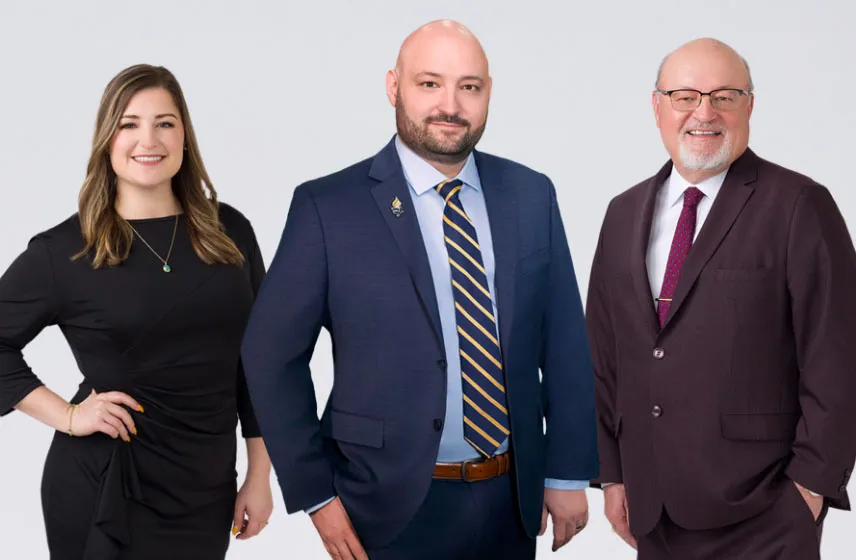
Walking down the Strip or elsewhere in Las Vegas can be a fantastic way to see the sights of the town while avoiding the snarls of traffic and the hassle of public transportation.
However, dangerous walkways, cracked and uneven sidewalks, and defects in pedestrian pathways can make you to lose your footing or stumble, sending you tumbling to the ground and causing injuries.
Partnering with experienced Las Vegas slip and fall attorneys from Bay Law following a trip accident is a crucial step toward receiving compensation for your injuries. Your slip and fall lawyer will be able to answer the question, “can you sue for tripping on a sidewalk?”
Does Clark County Have Liability from Suits?
Public sidewalks are usually the responsibility of the city or local municipality to maintain. When they fall into disrepair and you trip and fall, you may wonder, “can I sue the city for tripping on a sidewalk?” The answer to this question involves the application of a doctrine known as “sovereign immunity.”
NRS 41.033
Nevada Revised Statute 41.033 contains an exemption from liability for the State of Nevada and its political subdivisions and agencies. This statute states that the state, its political subdivisions like the City of Las Vegas, its agencies, and its employees and officers are all immune from civil liability for failing to inspect buildings, structures, and other public works or for not discovering hazards.
NRS 41.033 operates to say that Las Vegas and the city’s employees cannot be successfully sued using a theory of liability that they failed to conduct a reasonable inspection of the city’s sidewalks or that they failed to discover that their sidewalks presented a danger to you.
First, Take Some Time to Understand the Basics of Premises Liability
To appreciate the protections that NRS 41.033 provides to the state and its political subdivisions, you should understand premises liability law.
Ordinarily, the owner of property who opens that property to members of the public has a legal duty to take reasonable precautions to keep the property in safe condition for guests. This can include a duty to inspect the property and repair or warn of any dangers found. A property owner can be responsible for dangers that could have been discovered had they made a reasonable inspection.
Determining Liability for a Tripping Accident
If you are wondering “can you sue for tripping on a sidewalk,” the answer depends on the circumstances and location of your fall. Your slip and fall lawyer will begin by evaluating who might be responsible for causing the trip hazard to exist. Your slip and fall attorney will also look into whether these individuals are immune from liability under the law.
Identifying the Responsible Party
Responsible parties could include the property owner as well as any employee, manager, or even independent contractor who was charged with maintaining the safety of the fall location at the time your accident occurred.
Factors That Determine Liability
Liability for a trip and fall accident depends on showing whether the person or entity who owned and/or controlled the fall location acted reasonably to keep the property safe for others. This is a flexible standard depending on the circumstances. Often, a jury will consider whether inspections were done to discover dangerous conditions, whether the owner knew or should have known about the conditions, whether the conditions were corrected (or at the very least, warned about), whether the conditions were easy to identify, and even whether the person hurt was sufficiently protecting themselves and/or paying attention. This is not an exhaustive list of factors. Suffice it to say, establishing liability in a trip and fall accident can be a complicated balancing act.
Possible Defenses Against Liability
In light of the factors of liability, potential defenses to liability include claims raised by the other party that they:
- Are statutorily immune from suit
- Did not have ownership or control over the place where the accident occurred
- Did not give you permission to be present at the location where the accident happened
- Conducted reasonable inspections and still could not discover or have known about the danger
- Undertook reasonable measures to warn you or correct the danger
Your slip and fall attorney will be able to anticipate what defenses might be raised by the other party and how best to counter them.
Determining Negligence
Negligence has four prongs that must be proved to win your case: duty, breach of duty, causation, and damages. Did the property owner/manager owe a duty of care to keep the property safe for guests? Usually yes. Next, did the property owner/manager breach the duty of care by failing to take reasonable action to keep the property safe? This is a question of fact and depends on the circumstances in each case. Third, was the breach of duty the sole cause of your injuries or at least a 50% contributing factor? Finally, what is the extent of the damages/injuries that were caused? If you can meet all four of these prongs, you can likely recover money (damages) from your trip and fall case.
Gathering Evidence to Support a Lawsuit
You will also need to identify, preserve, and gather the evidence you will need to prove your claim in court, if necessary. The more evidence available to you, the greater the likelihood that you can obtain a favorable settlement without having to go to trial.
Types of Evidence That Can Be Used in a Lawsuit
Evidence will generally consist of tangible documents, photographs, video, reports, and the testimony of witnesses. Photographs, for example, can depict the dangerous walkway, but your testimony and that of your witnesses will explain and describe the scene and how the accident transpired.
How to Collect It
Collecting witness testimony depends on noting who is present at the scene of your accident and gathering their contact information for your slip and fall lawyer. If these people might become difficult to locate later on, your attorney may want to depose them and preserve their sworn testimony.
Evidence is preserved by identifying the person or entity with possession of that evidence. A preservation request is sent directing them to not destroy or alter the evidence in question. The custodian of this evidence can then be subpoenaed and told to bring the evidence with them to court or produce it for your attorney.
Filing a Lawsuit with a Slip and Fall Attorney
Your case may settle before you need to file a lawsuit. However, if the responsible party does not want to settle or won’t agree to acceptable terms, you will need to file a lawsuit. You may also need to file a lawsuit with assistance from a slip and fall lawyer to preserve your legal rights if the statute of limitations is close to expiring.
What Are Some of the Steps Involved?
Filing a lawsuit begins with the preparation and filing of a petition or complaint, which is a legal document setting forth your allegations and the reasons you believe the other party should pay you compensation. The other party is served with a copy of this document and has an opportunity to respond in writing.
After this, you and the other party will engage in a process called discovery, wherein you will exchange the information and evidence you both intend to rely upon in your case. Once discovery is completed, your case will go on the court’s trial docket and will be scheduled for trial.
What to Expect During the Process
Pursuing a claim for damages can be a lengthy process punctuated by periods of activity. You may have to appear for a deposition or meet with an attorney to respond to written questions. However, most of what happens will be handled directly by your attorney without the need for your personal involvement. Eventually, if your case does not settle in the interim, you will receive a trial date and have an opportunity to prove your claim to a judge or jury.
Settlements and Damages
When you file a lawsuit, you are asking the court to order the other party to pay you damages, which usually comes in the form of monetary compensation for your injuries. When you and the other party reach a settlement, it means the two of you have agreed on an amount of damages to be paid in return for you dropping your claim.
Types of Damages That Can Be Awarded in a Lawsuit
In a personal injury lawsuit, you can recover economic damages that compensate you for the money you have either lost or had to pay as a result of your accident and injuries. You are also able to pursue non-economic damages, which is money designed to compensate you for the mental pain, suffering, and trauma your injuries caused.
How Are Damages Calculated?
Damages in a slip and fall case are calculated by combining the cost of reimbursing you for your past and future medical needs with an additional amount to cover your non-economic damages.
Calculating compensation for non-economic damages involves considering how severely your injuries have affected your well-being. The more disruption your injuries have caused to your normal, everyday activities, the larger amount of compensation for non-economic losses you will likely receive.
What Are Considered Dangerous Surfaces and Conditions?
If you have ever wondered “can someone sue you for tripping on your property,” the answer depends on if the person was lawfully present and the nature of the hazard. If you permit a dangerous condition such as overly wet or slippery surfaces, a poorly lit walkway, or an uneven pathway to exist, you can be liable for damages.
A dangerous surface or condition leading to liability is one that a reasonable property owner would either correct or warn others about.
Dangerous Flooring Injuries
The National Floor Safety Institute (NFSI) provides sobering statistics about the serious injuries that can come from a fall. According to the NFSI, fractures are one of the more severe consequences of a fall and affect approximately one out of every twenty fall victims.
A hip fracture is especially severe and can lead to other health complications and even death. Fall victims can sustain fractures of other bones, injuries to their back and neck, and trauma to their head.
When Might the County Limit Not Apply?
You must generally file a lawsuit seeking damages for a trip and fall accident within two years of the accident, according to Nevada Revised Statutes section 11:190. There may be exceptions to this time limit, though, so you should speak with a slip and fall attorney about your situation.
Comparative Negligence in Las Vegas, Nevada
In a slip and fall accident caused by tripping on a walkway, you may be entitled to damages even if you were partly responsible for the accident.
Under Nevada Revised Statutes 41.141 and the state’s modified comparative negligence law, as long as your carelessness is not the primary cause of the accident, you are able to recover some compensation. The amount you receive would be lowered in proportion to how much your carelessness contributed to the accident.
Work with a Slip and Fall Accident Lawyer in Las Vegas to Get the Best Compensation for Your Case
Can you sue for tripping on a sidewalk in Las Vegas? Yes, and Bay Law would like to help. You might have the right to pursue compensation from the property owner, and our slip and fall lawyers are eager to help you exercise this right. Make them pay with Bay!




